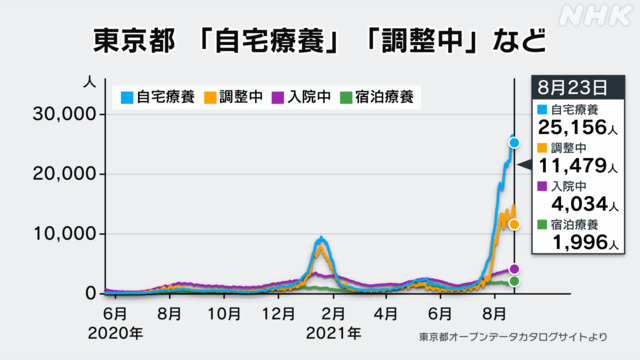いるシソを母が摘んで薬味に使っているが、葉がゴワゴワで厚く、あまり美味しくない。調べてみると、シソは半日陰くらいの場所で育てないとゴワゴワに葉が厚くなってしまうものらしい。水が足りないのも厚くなる原因とのこと。
ガーデニングQ&A|アースガーデン ~園芸用品~|アース製薬株式会社
庭のシソはカンカン照りの直射日光を浴びていて、地面もカラカラの砂利。これでは美味くないのも仕方ない。
いるシソを母が摘んで薬味に使っているが、葉がゴワゴワで厚く、あまり美味しくない。調べてみると、シソは半日陰くらいの場所で育てないとゴワゴワに葉が厚くなってしまうものらしい。水が足りないのも厚くなる原因とのこと。
ガーデニングQ&A|アースガーデン ~園芸用品~|アース製薬株式会社
庭のシソはカンカン照りの直射日光を浴びていて、地面もカラカラの砂利。これでは美味くないのも仕方ない。
という感じ。
病床確保など感染症法に基づく協力要請へ 国と都が医療機関に|NHK 首都圏のニュース
医療に対する恫喝だと憤る人もいるが、行政としては単に、残されている法的オプションはすべて使うという意味なのだろう。使わなければ「なぜ使わないんだ、行政の怠慢だ」と批判を受けるわけなので。ちゃんと仕事してますよ、という意味でしょう。
ただ実際に、今さらこんな要請を出したところで入院のキャパシティが有意に増えることはほぼ期待できないだろう。増やせるもんならとっくにやっとるわ、という話。東京だけで、入院中と宿泊療養中が6,000人いるのに対して、自宅療養中と「調整中」は合わせて36,000人いるという状況。無理である。

新型コロナウイルス 東京都のモニタリング項目|NHK特設サイト
強制力は医療に対してではなく、ワクチンを拒否して感染して医療リソースを圧迫する千葉真一みたいな困ったちゃんや、いまだに社員を通勤させ続けている俺のバイト先のような企業に対して行使すべきだろう。
dance practice video が永遠に見ていられる。
dance practice video と銘打った動画はたぶんこれが初めて。意外と言えば意外かも。1080p 60fps で気合が入っている。
ライブ参戦は断念したので、こういうのを見て楽しんでおります。
念のために来月もう一度肺CT。
帰りにファミマに寄ってカルピスのフラッペを初めて食べた(飲んだ)。氷をもみもみしてほぐしてからコーヒーマシンでフラッペ用の液体(ミルク?)を入れる。美味いけど300円はちょっと高い。